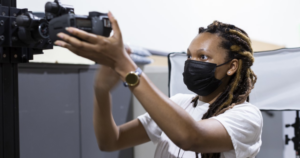Last autumn, Nateya Taylor took a class with UWM history professor Amanda Seligman and discovered a love for archival research. In fact, Taylor liked it so much that she decided to find an internship at a museum – maybe a Black history museum to align with her other research interests.
She’s now working at the biggest one in the country.
Taylor, a graduate student working toward her Master’s degree in urban studies at UWM, is spending the summer as a digitization and curatorial intern at the Smithsonian National Museum of African American History and Culture (NMAAHC). Located on the National Mall, the museum is the country’s premier institution detailing the history of Black Americans.
“I remember when it opened in 2016,” Taylor recalled. “(It was) my freshman year of college, and I really wanted to go but never had come to visit. So I was like, it’d be so cool to work there.”
She was right.
“I’m learning so much and I get to network with so many different people,” she said. “All the people are just very welcoming in the department that I’m working in. If you tell them what you’re interested in, then they’ll help you learn those skills that are beyond the job description.”
At the moment, Taylor is doing digitization work. She handles the museum’s archival objects, takes photographs of the materials, and then adds metadata to the files: the object’s origins, who donated it, its age, a description, and more. Digitization is important because the process not only makes the museum’s collection available to patrons who may only be able to access these materials virtually, but it also helps preserve archival materials that might be fragile, like a fading photograph or a crumbling piece of paper.
The NMAAHC also partners with outside institutions and organizations to help preserve their records. Currently, Taylor is working on digitizing a collection of archival materials from St. Paul’s College, a now-shuttered historically Black college in Lawrenceville, Virginia. The materials date back to the 1930s, and Taylor and her fellow interns are hoping to help preserve this bit of history.
As much as she enjoys working older collections like these, Taylor says the coolest artifact she’s seen in the museum is actually fairly young: “One of the cool things I got to see that the museum has is the Black Panther costume that Chadwick Boseman wore in the Marvel movie. That was just so amazing,” she said.
Beyond the artifacts, Taylor says that the best part of the internship has been the chance to be mentored and grow her skills, both as an archivist and as a photographer and filmmaker. The interns receive professional development and have been invited to conferences and seminars to learn more about the field.
Living in Washington, D.C. for the summer has also been an exciting experience, Taylor added. She’s navigated the city’s metro system and has enjoyed getting to know the neighborhood where she’s staying for the summer.
The capital is a long way from Milwaukee, Taylor’s hometown. She attended Carthage College in Kenosha, Wisconsin, for her Bachelor’s degree, where she majored in criminal justice with a pre-law concentration. Taylor had plans to be a lawyer, and even took the LSATs, before realizing that law wasn’t the right path.
“I did my senior thesis on Milwaukee Black health, looking at how segregation impacts Black Milwaukeeans’ overall health. That inspired me to do this urban studies Master’s degree at UW-Milwaukee because it’s so interdisciplinary, looking at urban problems and why they occur,” Taylor said.
That interdisciplinary focus has been invaluable at her internship. It’s one thing to learn facts in class, Taylor noted, but learning how to think critically, approach history from different perspectives, and challenge her own assumptions has led her to success.
It’s also made her more thoughtful about history, race, and education in America.
“I think that (this internship) has made me think about how we don’t go into depth about Black history and how there’s so much left out. When I went to the museum, there’s a lot of stuff that I didn’t even know about Black history,” she said. “I think that if we do pay attention to Black history and actually learn it, then it can help us to come together and understand each other better, instead of continuing to have instances where people are discriminating against Black people, whether it’s in healthcare, whether it’s the government, whether it’s the criminal justice system.”
Taylor’s Smithsonian internship ends in August. She already has another internship lined up for after she returns – this time at America’s Black Holocaust Museum in Milwaukee.
